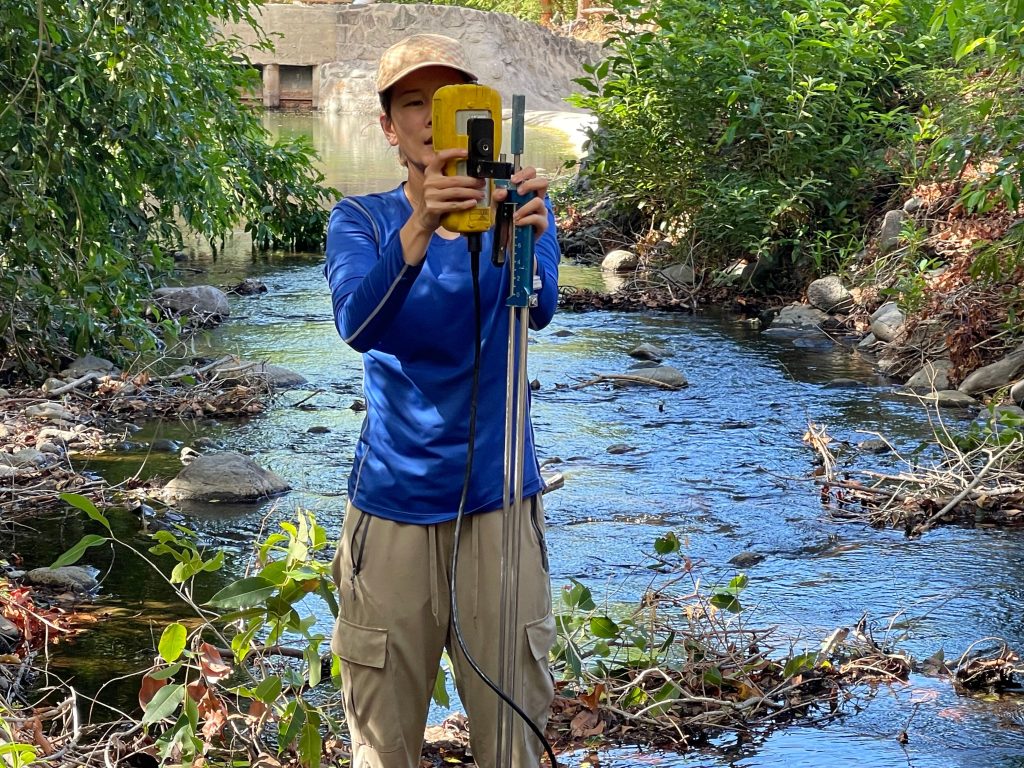10/23/23-A HYDROLOGISTS PRIMER ON INTERIM INSTREAM FLOW STANDARDS
Posted on Oct 23, 2023 in Commission On Water Resources Management, Main, Media, News Releases, slider| JOSH GREEN, M.D. GOVERNOR |
DAWN CHANG
CHAIRPERSON |
FOR IMMEDIATE RELEASE
Oct. 23, 2023
A HYDROLOGISTS PRIMER ON INTERIM INSTREAM FLOW STANDARDS
To view video please click on photo
(OLOWALU, MAUI) – From the banks of Ukumehame Stream, looking to the top of the West Maui Mountains, you’d imagine you’re taking in a view of the desert Southwest. The barren landscape provides a dramatic example of how climate change and drought are impacting lands and how limited water resources are allocated.
Over the past seven years, staff with the Commission on Water Resource Management (CWRM) have brought interim instream flow standards (IIFS) before the commission for review and approval. Dozens of streams on Maui, Moloka‘i, Kaua‘i, and Hawai‘i Island now have IIFS, which allows for adaptive management in an ever-changing environment.
“IIFS require collection and analysis of data, engagement with community and water users, and a balance of needs before any commission action,” explained CWRM Hydrologist Dr. Ayron Strauch.
He spends a great deal of time standing in streams to gather measurements and data that help inform recommendations and compliance for waterways that already have standards in effect.
“We’d like to have the resources to monitor every stream in the state and to develop IIFS for each of them. However, we have to prioritize our limited resources by focusing on areas (hydrological units) where there are potential conflicts. These include plantation systems that may affect stream flow, harm to traditional and customary practices, or areas identified as candidate streams for protection by the Hawai‘i Stream Assessment,” Strauch said.
The goal, he said, isn’t to eliminate conflicts but to provide more balance in the equitable use of water. IIFS are designed to protect streams and instream values.
“Essentially IIFS reduce the use of water for non-instream uses, particularly under low-flow conditions. We really seek to prioritize public trust uses over non-public trust uses and IIFS are one tool that helps us do that,” Strauch added.
The devastating August fires on Maui, brought a lot of attention to how water is used and allocated on the Valley Isle. Strauch believes the fires won’t change the values that need to be protected by IIFS but believes the water commission may look at water use permits in a different light in the future. “I don’t believe the fires will have any long-term consequences for instream flow standards,” he said.
Away from the shade and coolness of the stream beds, where Strauch and hydrologist Cody Chacon collect data, the vegetation is mostly sparse and dry. Except for nearby lo‘i, with vibrant kalo.
“There definitely has been more emphasis on the protection of aquatic life and traditional and customary practices. By restoring meaningful, quantifiable IIFS, people have come back to their kuleana lands and started to grow more kalo and have reopened historic lo‘i and are spending time in the streams that didn’t have flowing water for generations,” Strauch reflected.
On a scorcher of a day in early October he and Chacon set up equipment to take measurements used to calibrate data loggers, that are permanently installed near the stream’s bank, and produce continuous measurements. “One of the benefits of increased data collection is we get to understand how water availability is changing, how variable it is, and how climate change is impacting our resources,” Strauch explained.
“We’d like to do this, every eight weeks, at each of the 70 some streams around the state currently with standards. In reality, we’re fiscally constrained to maybe visiting each stream every three to four months,” Strauch said.
How ground and surface water are allocated is but one piece of a complex puzzle, with climate change introducing many variables and unknowns.
“In west Maui particularly, we’ve seen a major decline in rainfall resulting in a decline in groundwater recharged. That in turn has negative consequences on stream flows. We’ve seen historically low stream flows coupled with 500-year storm events which are unprecedented. The big unknown is the 10 to 30-year window. How much more rapidly are things going to change?” Strauch wondered.
According to Strauch a number of Hawai‘i streams could benefit immediately from restored stream flows. “Simultaneously there needs to be a concerted effort to restore riparian vegetation, estuaries, and watersheds holistically to really reap the benefits of IIFS.”
He feels Hawai‘i is better positioned than most western states to address the variables and unknowns. Hawai‘i water laws are unique in that they emphasize the protection of public trust uses. “At the same time, our unique hydrology makes things like surface and groundwater interactions very complex and difficult to understand. It is challenging integrating the science with the law,” he concluded.
# # #
RESOURCES
(All images and video courtesy: DLNR)
HD video – IIFS Explained in Three Minutes:
HD video – West Maui CWRM stream visits-media clips (Oct. 4, 2023):
Photographs – West Maui CWRM stream visits (Oct. 4, 2023):
https://www.dropbox.com/scl/fo/b91b56r6a83gg1sw3t272/h?rlkey=fht7ygfhcej5nnwl1033zrqxu&dl=0
Media Contact:
Dan Dennison
Communications Director
(808) 587-0396
[email protected]
